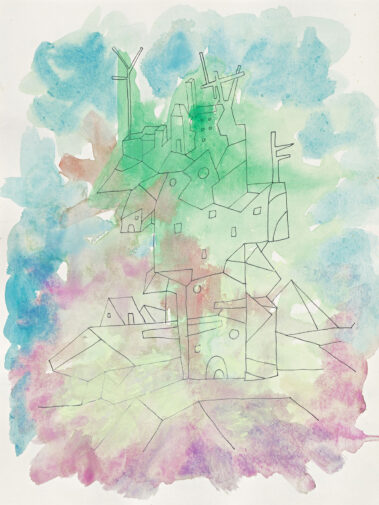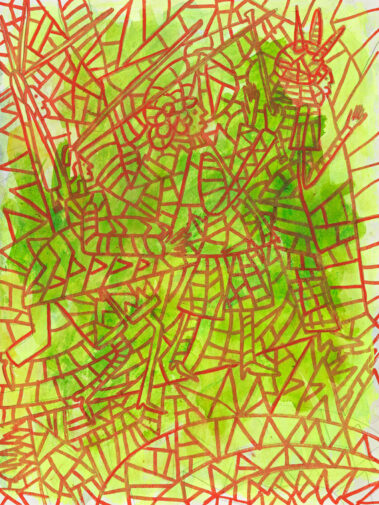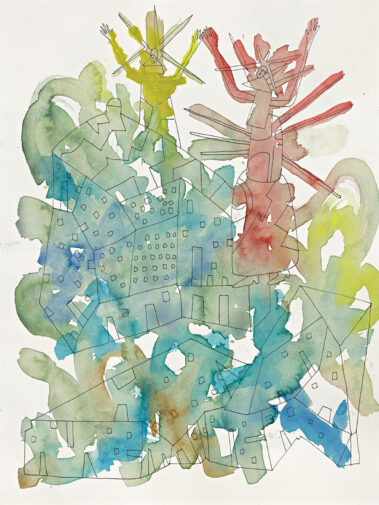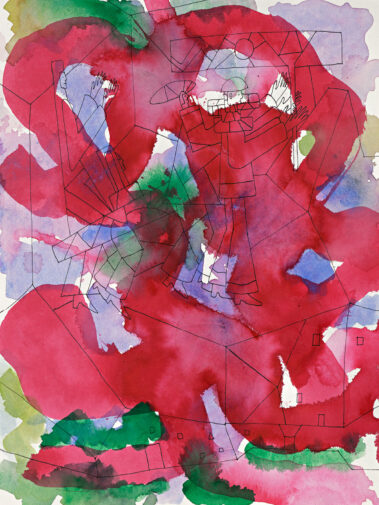When artists travel
When artists travel, they take their special view of the world along in their baggage. The painter Sebastian Heiner has traversed the globe a number of times with trips to Israel, Jordan and the Caucasus. On a number of occasions, he was able to combine his travels with prolonged work orientated stays in cities such as Bangkok, Beijing and Shanghai. These changes of location (and consequent cultural contexts) in recent years are reflected in the development of his large-format paintings, graphics and performances. Now, for the first time, he has produced a series of texts written during his recent stay in Shanghai (2017), which were then revised and enhanced upon with the assistance of the philosopher Steve Long. During the same period, Sebastian Heiner also completed a series of impressive abstract works and conducted a painting performance, which has been recorded on video. His perspective on Shanghai as a prototypical Moloch City is complemented by the intense photographs of Michael Wruck.
When artists write
The art historian Michael Glasmeier has described the texts written by artists as „an independent medial form of art, when one concurs that art is essentially an intellectual pleasure, both for its producers and audience.”. He goes on to explain: „To understand not only contemporary art, it is more than helpful to accept the different roles assumed by artists and thereby the outstanding experimental and exploratory character of art. It is therefore about the standpoint adopted by thoughtful and reflective artists, an activity that does not always have to be expressed in painting, but for whom the text is another and different medium of expression.”. On this basis, the texts by Sebastian Heiner should not be read as if directly related to his paintings, but instead as opening up a portal to his thought processes and reflections.
Sebastian Heiner’s tracts weave between reality and fiction, between everyday experiences and dreams, between the present and utopia. In dream-like sequences such as “Food“ and „The Orange Cloud“ the artist assumes the perspective of a nameless protagonist and describes a future world / mass society in a state of continual renewal which places enormous pressure upon its subjects. In his expositions „Colour“ and „Cat“, Sebastian Heiner allows us to participate directly in his work process, sharing his thoughts and emotions, which are sometimes bound up with fears or contradictory impulses. The creative act of painting and the production of images is thereby demystified and made comprehensible to the layman. A third related set of texts focus on sensory perceptions in a foreign environment. Heiner uses poetically condensed language to describe his impressions – and makes clear that in today’s increasingly digitised world we still perceive and construct our world exclusively through our sensory organs. In toto, the texts constitute a means for the artist to acquire distance from himself, enabling him to describe sensory impressions, emotions, thoughts and dreams which provide the basis for a psychogram of the artistic subject.
When artists create figures
For the first time, Sebastian Heiner has produced a series of mainly figurative watercolours. Initially, one is struck by the contours of the figures, which are then partially painted over or broadly filled out. These pages are populated by figures moving through urban landscapes, one at a time, in pairs, or accompanied by animals, vehicles and flying objects. Heiner’s protagonists are attired in seemingly timeless robes, carrying or balancing objects on their heads, some of which appear to be antennae. In any event, the origins of the actions and poses struck by these apparently genderless beings remain both fantastic and enigmatic to the viewer. This impression is reinforced by colours and surfaces which flow into one another.
The watercolours were produced independently of the small essays so there is no automatic connection between the two. Nevertheless, it is possible to reconstruct a compositional dramaturgy that results from the non-linearity of the images and texts. Reading or flicking through these can cause both confusion and irritation, as well as pleasure and surprise.
A final thought
This book takes us on a stimulating and varied journey, allowing us to immerse ourselves in the hitherto unknown visual and textual landscapes of the artist, which, at the same time, open up an expansive cognitive and artistic space. Sebastian Heiner creates works that have a strange yet poetic effect that lingers long after seeing them. Tantalising links emerge between his and our own stories confronting us with the increasingly complex web of historical, cultural and personal conditions and relationships in which we live. In the final analysis, whether in the form of his watercolours, paintings, performances, photographs or texts, it is up to the viewer to make the final judgement on Heiner‘s own perspective.
Audrey Hörmann
Wenn Künstler auf Reisen gehen
Wenn Künstler auf Reisen gehen, dann haben sie sich selbst und ihren spezifischen Blick auf die Welt mit im Gepäck. Der Maler Sebastian Heiner hat bereits zahlreiche Länder besucht und war unter anderem in Israel, Jordanien und dem Kaukasus unterwegs. Weitere Reisen konnte er mit längeren Arbeitsaufenthalten in Bangkok, Peking und Shanghai verbinden. Dadurch änderte sich in den letzten Jahren mehrmals der kulturelle Kontext, in dem seine großformatigen Gemälde, Grafiken und Performances entstanden. Sebastian Heiner verfasste bei seinem letzten Shanghai-Aufenthalt im Jahr 2017 auch eine Reihe von Texten, die er im Anschluss gemeinsam mit dem Philosophen Steve Long überarbeitete. In Shanghai gestaltete er einen Teil seiner eindrücklich abstrakten Gemälde und in Berlin realisierte er eine Mal-Performance, die filmisch dokumentiert wurde. Komplementiert wird Sebastian Heiners Perspektive auf Shanghai als prototypische Moloch-Stadt durch die verdichteten Fotografien von Michael Wruck, der sich gleichzeitig dort aufhielt.
Wenn Künstler schreiben
Der Kunstwissenschaftler Michael Glasmeier versteht Künstlertexte als „eine eigenständige mediale Form von Kunstwerken, wenn wir zu der Einsicht gelangen, dass Kunst wesentlich ein intellektuelles Vergnügen ist, sowohl für die Macher wie für die Hingucker.“ Denn, so führt er weiter aus: „Zum Verständnis nicht nur der zeitgenössischen Kunst könnte es aber mehr als hilfreich sein, die verschiedenen Rollen der Künstlerinnen und Künstler zu akzeptieren und damit den herausragenden experimentellen und forschenden Charakter von Kunst. Es geht also um die Position der denkenden und reflektierenden Künstlerinnen und Künstler, eine Tätigkeit, die sich eben nicht nur und nicht immer im Bild niederschlagen muss, sondern für die der Text ein weiteres und anderes Medium des Sagens ist.“ Vor diesem Hintergrund lesen sich die Texte von Sebastian Heiner weniger ‚parapiktural’, sondern eröffnen dem Leser ein Eintauchen in die Gedankenwelt und die Reflexionen des Künstlers.
Sebastian Heiners Texte bewegen sich zwischen Realität und Fiktion, zwischen Alltagswahrnehmung und Traum, zwischen Gegenwart und Utopie. So beschreibt der Künstler in traumähnlichen Sequenzen wie etwa Nahrung und Die orangene Wolke aus der Perspektive eines namenlosen Protagonisten eine zukünftige Welt beziehungsweise Massengesellschaft, die sich ständig erneuert und in der die Menschen deswegen permanent überfordert sind. In den Texten Farbe und Katze lässt uns Sebastian Heiner mittels seiner emotionalen und reflektierenden Beschreibungen unmittelbar an seinem Arbeitsprozess teilhaben, der manchmal auch mit Ängsten oder Widersprüchen verbunden ist. Der schöpferische Akt des Malens und der Bildproduktion wird somit entmystifiziert und für den Laien nachvollziehbar gemacht. Einen dritten inhaltlichen Strang bilden die Texte mit einem Fokus auf die sinnliche Wahrnehmung in einer fremden Umgebung.
Heiner beschreibt mit einer poetisch verdichteten Sprache seine Sinneseindrücke. Dabei wird deutlich, dass wir unsere Umgebung in einer zunehmend digitalisierten Welt immer noch ausschließlich über unsere Sinnesorgane wahrnehmen und konstruieren. Alle Texte fungieren für den Künstler als Methode, um Abstand zu sich selbst zu gewinnen. Dadurch ermöglichen sie ihm die Beschreibung von Sinneseindrücken, Emotionen, Gedanken sowie Träumen und zeichnen damit das Psychogramm eines künstlerischen Subjekts nach.
Wenn Künstler Figuren erschaffen
Nach seinem Aufenthalt in Shanghai produzierte Sebastian Heiner auch figurative Aquarelle. Formal fallen die Konturenlinien der gezeichneten Figuren auf, die teilweise übermalt oder flächig gefüllt werden. Bevölkert werden diese Blätter von Gestalten, die sich einzeln, zu zweit oder in Begleitung von Tieren, Fahrzeugen und Flugobjekten durch urbane Landschaften bewegen. Heiners Protagonisten sind allesamt in zeitlos wirkende Gewänder gekleidet und tragen oder balancieren Objekte auf ihren Köpfen, die teilweise an Antennen erinnern. Dennoch bleiben die Herkunft, die vollzogenen Gebärden sowie das Handeln der schein-bar geschlechtslosen Wesen für den Betrachter zugleich fantastisch und rätselhaft. Verstärkt wird dieser Eindruck durch die teils zerfließenden Farben und Flächen.
In Verbindung mit den Texten ergeben sich teilweise inhaltliche Kohärenzen, obwohl die Aquarelle unabhängig von den Texten angefertigt wurden. Dennoch lässt sich eine spannungsvoll komponierte Dramaturgie nachvollziehen, die sich aus der Non-Linearität der Bilder und Texte ergibt. Diese rufen bei der Lektüre oder beim Blättern ebenso Verwirrung und Irritationen wie auch Vergnügen und Überraschungen hervor.
Schlussgedanke
Das Buch nimmt uns mit auf eine abwechslungsreiche Reise: Wir können in bisher unbekannte Bild- und Textlandschaften des Künstlers eintauchen, die zugleich einen erweiterten Denk- und Kunstraum eröffnen. Sebastian Heiner schafft Werke, die eine irritierende und zugleich poetische Wirkung haben, noch lange nachdem man sie gesehen und gelesen hat. Zwischen seinen und unseren eigenen Geschichten ergeben sich merkwürdige Verbindungen, die uns mit den komplexen historischen, kulturellen und persönlichen Bedingungen und Beziehungen konfrontieren, in denen wir leben. Doch unabhängig davon, ob es sich um Sebastian Heiners Aquarelle, Gemälde, Performances oder Texte handelt, bleibt bei allen aus seiner Perspektive erzählten Geschichten die eigene Deutung dem Betrachter überlassen.
Audrey Hörmann



